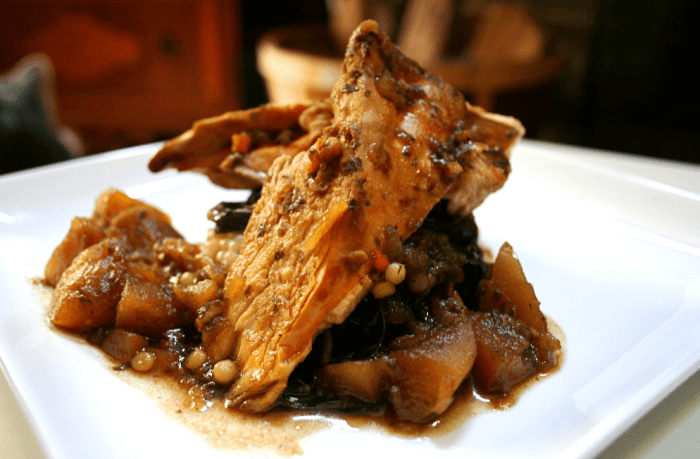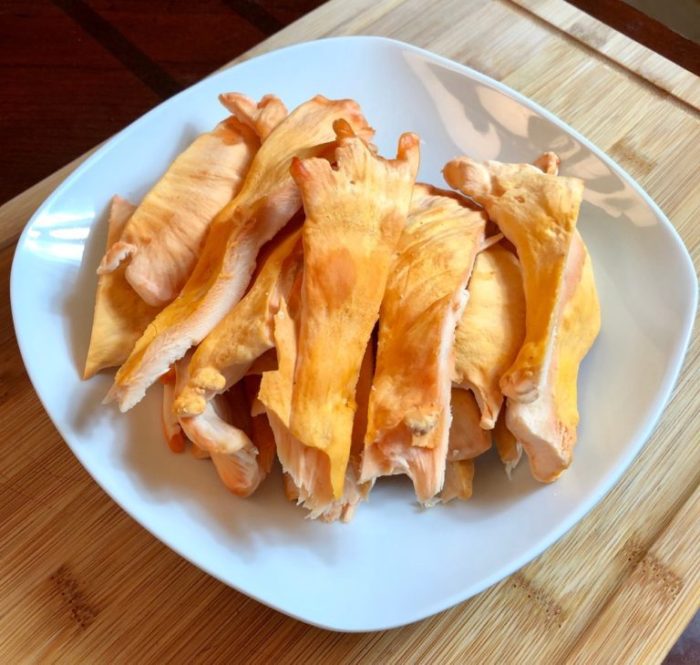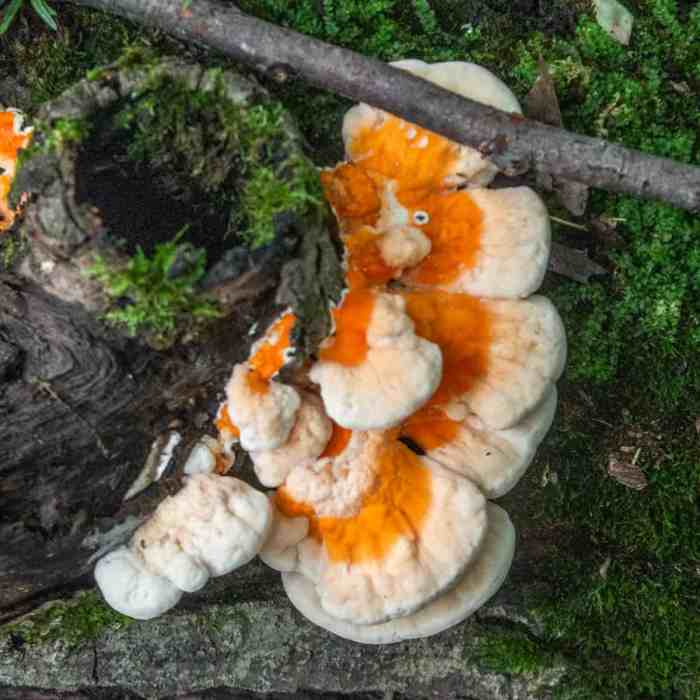
Embark on a culinary adventure with our comprehensive guide to chicken of the woods recipe. This versatile mushroom offers a unique taste and texture that will tantalize your taste buds. From identification and foraging to cooking techniques and health considerations, we’ve got you covered.
Chicken of the woods, with its vibrant colors and meaty texture, is a culinary delight waiting to be discovered. Join us as we explore the world of this extraordinary fungus, empowering you to create mouthwatering dishes that celebrate the bounty of nature.
Nutritional Benefits of Chicken of the Woods

Chicken of the woods is a nutritional powerhouse, boasting an impressive array of vitamins, minerals, and antioxidants.
It is an excellent source of protein, containing all essential amino acids necessary for optimal health. This protein content makes it a great meat alternative for vegetarians and vegans.
Fiber
Chicken of the woods is also rich in fiber, both soluble and insoluble. Soluble fiber helps regulate blood sugar levels and reduce cholesterol, while insoluble fiber promotes digestive health and regularity.
Vitamins
This mushroom is an excellent source of vitamins, including vitamin C, niacin, riboflavin, and vitamin D. Vitamin C is crucial for immune function and antioxidant protection, while niacin supports metabolism and nerve function. Riboflavin aids in energy production, and vitamin D is essential for bone health.
Minerals
Chicken of the woods is also a good source of minerals such as potassium, phosphorus, and iron. Potassium helps regulate blood pressure and fluid balance, phosphorus supports bone health and energy metabolism, and iron is essential for red blood cell production.
Health Benefits
Consuming chicken of the woods has been linked to several potential health benefits:
- Improved immune function due to its high vitamin C content.
- Reduced inflammation due to its antioxidant properties.
- Lower cholesterol levels due to its soluble fiber content.
- Improved digestive health due to its insoluble fiber content.
Culinary Applications of Chicken of the Woods: Chicken Of The Woods Recipe

Chicken of the woods is a versatile culinary mushroom that can be prepared in a variety of ways. Its meaty texture and mild flavor make it a great substitute for chicken in many dishes.
One of the most popular ways to cook chicken of the woods is to sauté it. This method is quick and easy, and it allows the mushrooms to retain their natural flavor. To sauté chicken of the woods, simply heat some oil in a pan over medium heat.
Add the mushrooms to the pan and cook until they are browned and tender.
Roasting
Roasting is another great way to cook chicken of the woods. This method brings out the mushrooms’ earthy flavor and gives them a slightly crispy texture. To roast chicken of the woods, preheat your oven to 400 degrees Fahrenheit. Toss the mushrooms with some olive oil, salt, and pepper, and then spread them on a baking sheet.
Roast the mushrooms for 15-20 minutes, or until they are tender and browned.
Grilling, Chicken of the woods recipe
Grilling is a great way to cook chicken of the woods if you want to give them a smoky flavor. To grill chicken of the woods, preheat your grill to medium-high heat. Brush the mushrooms with some olive oil, and then grill them for 5-7 minutes per side, or until they are tender and browned.
Frying
Frying is a great way to cook chicken of the woods if you want to give them a crispy texture. To fry chicken of the woods, heat some oil in a large skillet over medium heat. Dip the mushrooms in some flour, and then fry them in the hot oil until they are golden brown and crispy.
Chicken of the woods is a versatile mushroom that can be used in a variety of dishes. Its meaty texture and mild flavor make it a great substitute for chicken in many recipes.
Identification and Foraging of Chicken of the Woods
Chicken of the woods ( Laetiporus sulphureus) is a large, edible mushroom that grows in clusters on the trunks of dead or dying hardwood trees, especially oaks. It is a common mushroom in North America and Europe, and is prized for its meaty texture and delicious flavor.
Chicken of the woods is characterized by its bright orange to yellow color, and its large, shelf-like shape. The mushroom can grow up to 12 inches in diameter and 6 inches thick. The flesh is white and firm, with a slightly sour taste.
Chicken of the woods is typically found in the spring and fall, and can be foraged in forests and woodlands.
Identification Tips
- Color:Chicken of the woods is typically bright orange to yellow, but it can also be white or cream-colored.
- Shape:The mushroom is large and shelf-like, with a wavy or lobed margin.
- Size:Chicken of the woods can grow up to 12 inches in diameter and 6 inches thick.
- Flesh:The flesh is white and firm, with a slightly sour taste.
- Habitat:Chicken of the woods grows in clusters on the trunks of dead or dying hardwood trees, especially oaks.
Avoiding Poisonous Look-alikes
There are a few poisonous mushrooms that can be mistaken for chicken of the woods, so it is important to be able to identify the key differences. The most common poisonous look-alike is the jack-o’-lantern mushroom ( Omphalotus illudens). The jack-o’-lantern mushroom is also bright orange, but it has a slimy cap and gills, and it grows on the ground.
If you’re craving a meatless meal, the chicken of the woods recipe is a must-try. This hearty fungus is a delicious and nutritious alternative to chicken, and it’s perfect for vegetarians and meat-eaters alike. The recipe is simple to follow and the result is a flavorful dish that’s sure to please everyone at the table.
Another poisonous look-alike is the sulfur tuft mushroom ( Hypholoma fasciculare). The sulfur tuft mushroom is smaller than chicken of the woods, and it has a yellow to green cap with a slimy surface.
If you’re looking for a unique and delicious vegetarian dish, try out the chicken of the woods recipe . This edible fungus has a meaty texture and a slightly nutty flavor, making it a great substitute for chicken in your favorite recipes.
It’s also packed with nutrients, so you can feel good about enjoying this healthy and flavorful dish.
Ethical and Sustainable Foraging
When foraging for chicken of the woods, it is important to be ethical and sustainable. This means only harvesting mushrooms that are mature and healthy, and leaving enough mushrooms behind for other foragers and wildlife. It is also important to avoid damaging the trees that the mushrooms are growing on.
Comparison to Other Edible Mushrooms
Chicken of the woods stands out among edible mushrooms with its distinct flavor, texture, and nutritional value. Let’s compare it to popular mushrooms like shiitake, oyster, and portobello.
Flavor and Texture
Chicken of the woods has a meaty, umami-rich flavor that mimics the taste of chicken. Its texture is firm and tender, making it suitable for various cooking methods. Shiitake mushrooms have a deep, earthy flavor with a slightly chewy texture.
Oyster mushrooms offer a mild, briny flavor and a soft, velvety texture. Portobello mushrooms have a smoky, nutty flavor and a firm, dense texture.
Nutritional Value
Chicken of the woods is a good source of protein, fiber, and vitamins. It contains higher levels of potassium and vitamin C than shiitake and oyster mushrooms. Portobello mushrooms have the highest amount of iron among these mushrooms.
Culinary Applications
Chicken of the woods’ unique flavor and texture make it a versatile ingredient. It can be grilled, roasted, fried, or stewed. Its meaty texture makes it a great substitute for chicken in various dishes. Shiitake, oyster, and portobello mushrooms are commonly used in soups, stir-fries, and salads due to their mild flavors and textures.
Substitutes for Chicken of the Woods
If chicken of the woods is unavailable, shiitake or portobello mushrooms can be used as substitutes in some recipes. However, they may not fully replicate the unique flavor and texture of chicken of the woods.
Health Considerations and Safety

While chicken of the woods is generally safe to consume, there are a few potential health concerns to be aware of. Some people may experience allergic reactions to the mushroom, characterized by symptoms such as skin rashes, nausea, and vomiting.
When it comes to chicken of the woods , I’ve got a recipe that will make your taste buds dance. It’s an easy-to-follow guide that takes you through every step, from foraging to preparation. So whether you’re a seasoned mushroom hunter or just starting out, give this recipe a try.
You won’t be disappointed.
It’s essential to consult a healthcare professional if you suspect an allergic reaction.
To ensure the safety of chicken of the woods, proper handling and storage are crucial. Freshly harvested mushrooms should be cleaned thoroughly to remove any dirt or debris. Store them in a paper bag or a loosely covered container in the refrigerator for up to 3 days.
Cooked chicken of the woods can be stored in an airtight container in the refrigerator for up to 5 days or in the freezer for up to 3 months.
Cooking Chicken of the Woods Thoroughly
Thoroughly cooking chicken of the woods is essential to eliminate any potential toxins. Raw or undercooked mushrooms may contain harmful substances that can cause gastrointestinal distress. It’s recommended to cook chicken of the woods until it reaches an internal temperature of 165°F (74°C).
This can be achieved by sautéing, grilling, or roasting the mushrooms.
Final Wrap-Up

As you venture into the world of chicken of the woods, remember to embrace the joy of foraging and the satisfaction of preparing a meal from scratch. Whether you’re a seasoned chef or a culinary novice, our guide will equip you with the knowledge and inspiration to create dishes that will impress your palate and nourish your body.
Happy foraging and cooking!
FAQ Insights
Is chicken of the woods safe to eat?
Yes, chicken of the woods is generally safe to eat when cooked thoroughly. However, it’s crucial to identify it correctly to avoid consuming poisonous look-alikes.
How can I identify chicken of the woods?
Chicken of the woods typically has a bright orange or yellow color, a ruffled texture, and grows in clusters on trees or logs. It’s important to consult field guides or consult with experienced foragers for accurate identification.
What are the health benefits of chicken of the woods?
Chicken of the woods is a good source of protein, fiber, and various vitamins and minerals. It may also have antioxidant and anti-inflammatory properties.





